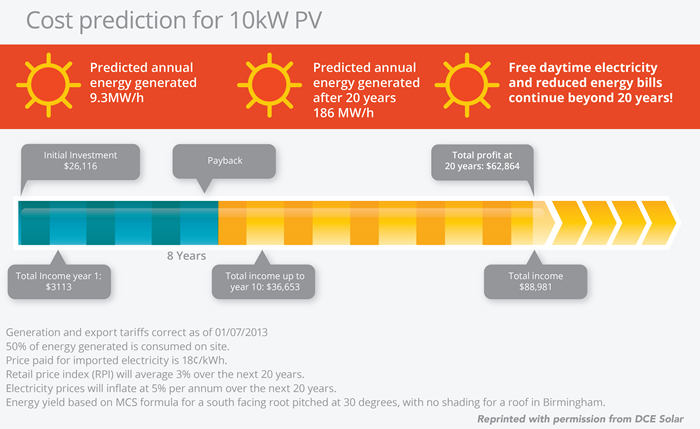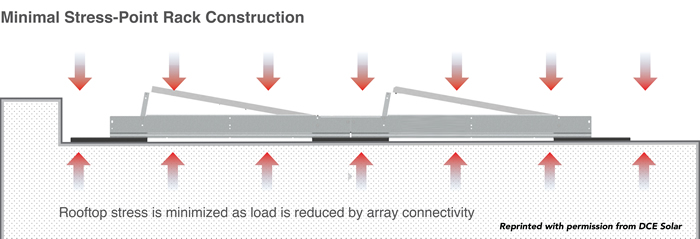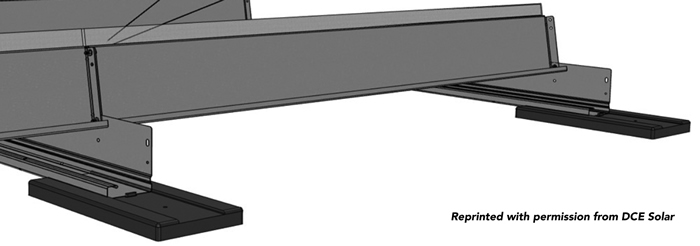Contractors, builders, roofing companies, and property managers have a rare and unique opportunity to profit from the expansion of solar as it becomes more and more mainstream.
Maximizing the Benefits of Roof-Mounted Solar Arrays for Commercial Buildings
Contributed by | DCE Solar
Even though the solar energy market is relatively young (widespread usage outside the energy industry only first started gaining momentum in the early 2000s), the strong return on investment is undeniable. Not only have solar panels and mounting equipment become more cost effective in recent years, but various federal and state incentives have lowered the practical start-up costs of new systems.

What’s more, with many energy providers now offering credits and offsets to customers who install and utilize solar energy, commercial property owners are realizing savings that can reduce or eliminate energy consumption costs and also minimize overall environmental impact from other operations such as delivery trucks, production costs, and more. So it comes as no surprise that companies with 5,000 square feet or more of lowslope roof space are eager to incorporate solar arrays.
Getting on Top of the Opportunity
While the advantages of solar are becoming increasingly clear to business and property owners, the construction and roofing technology has been slower to adapt to this new element of building structures. As such, some inherent challenges must be addressed in order to ensure maximum satisfaction and return on investment for business and property owners.
Challenge #1: The Gap Between Roof Function and Roof Construction
For decades, the primary purpose of a roof has been to protect interior structures from exterior elements such as water, weather, and more. Construction methodology has followed this idea and sought to make commercial roofs more reliable and affordable through the use of lightweight materials and minimal structures that support large spans.

In order for existing roofs to successfully accommodate a new purpose - serving as a support platform for solar equipment - additional technical aspects must be considered in order to ensure long-term performance of the roof and any existing warranties.
The National Roofing Contractor Association (NRCA) has been supporting this philosophy with solar technical programs, certifications (such as RISE), and various installation recommendations. Likewise, top solar equipment manufacturers are creating systems that mitigate challenges and allow for simpler, more successful installations from the outset, without the need for specialized training.
Challenge #2: The Age of Roofs vs. the Age of Solar Systems
Unless the commercial property is a new build or has a new roof installed within the past 2-5 years, it is likely that the roof will need service or replacement well in advance of any solar being installed. Most solar systems today have life expectancies between 25-30 years, while roof systems are typically built to satisfy 20-year warranties. The additional cost of 25 to 30-year roof warranties are often unattractive to property owners that first installed roofs for “standard” purposes only.
If a roof system cannot be expected to last the life of a solar array, it will require disassembly and re-installation of solar equipment in order to service or replace the roof – thus doubling the expense of the solar installation. Selling roof systems and solar arrays together is one way to address this challenge. However, the more practical approach is to utilize equipment that has the least amount of negative impact on the existing roofing system.
Challenge #3: Actual Roof Performance vs. Solar Array Impact
Even with warranties in place, the current estimated performance life of a lowslope commercial roof is around 17 years. This leaves at least eight to ten years in which the solar array could be in useful service. At the same time, a number of factors can reduce that lifespan even further – some related to the roof, and others related to the solar array.
- Lack of regular roof maintenance can create functional weaknesses that are amplified by the installation of a solar array.
- Inexpensive roofing systems or repair materials are typically poorly suited for roof top solar installations of any type.
- Roof-mounted solar arrays increase the amount of regular foot traffic the roof must sustain – both during construction and afterwards.
- Mechanically attached PV racks increase roof system penetrations, while ballasted systems increase load points and possible insulation compression throughout the roof span.
- Improper installation of arrays can impede or block drainage and increase ponding water and surface wear.
Rising to the Challenges
LEADING-EDGE SYSTEMS FOR SOLAR SUCCESS
In order for contractors, roofing consultants, and solar energy advisors to successfully address the main challenges of installation, equipment selection is critical. Therefore, choosing racking systems designed to address the realities of current and future roofing conditions can have a direct impact on bottom-line results for installers.
Today’s top-performing racking systems include features that specifically address such common-yet-important situations as:
MINIMAL ROOF SURFACE CONTACT

Systems built on footings that channel or block water can change the fundamental ability of the roof to drain water properly and protect interior contents from damage. Ponding may also occur around the rack base, contributing to problems such as decreased watertight integrity and instability for the entire system. Surprisingly, these larger, bulkier racking systems are often more expensive – both to purchase and to install. The truth is, these systems were created with limited knowledge or consideration of the negative impact they have on the roofing system.
OPTIMIZED TOTAL SYSTEM WEIGHT
Because of accepted building codes and commercial clients’ desire for cost efficiencies, the vast majority of commercial roofing systems are built to accept maximum weight loads that create a structural loading design problem, requiring total PV system loads to come in less than 4 psf. This fact often determines whether or not a ballasted system or attached system is more appropriate for a particular commercial property. However, since roof warranties are often voided when surface membranes are deliberately penetrated, attached systems are only used in a limited number of situations. At the same time, higher-level wind zones require additional ballast requirements in order to properly anchor the system. It is therefore important that a system be light enough to accept minimal ballast weights without exceeding maximum roof weight thresholds.
Rising to the Challenges
Streamlined construction with low-weight, high-strength materials can keep total system weight at less than 4 psf – allowing for direct installation to existing roof systems without risking damage to the roof’s structural components.
INTEGRATED ROOF PROTECTION
Steel and concrete are definitely top material choices when it comes to strength and durability, but they present special challenges to roofing systems. They may cause abrasions or punctures at contact points, or accelerate corrosive conditions through rust or erosion. Alternatively, the insulation on top of structural decks may become compressed at peak load points which can cause ponding and even leaks. To date, the accepted remedy has been to cover the roof area designated for a PV array with compatible slip sheets for the existing roof system. Not only can this be quite costly, but it is often unnecessary when a lightweight PV racking system with integrated protection pads is chosen.
Recycled rubber ballast pads provide safe mounting surfaces with a high coefficient of friction. When integrated into system bases, loads are reduced, vibration is minimized, and in most cases, the need for slip sheets is eliminated.
DURABLE BALLAST CHOICES
Conventional thinking is that one source of ballast weight is as good as another. However, like many situations in building and construction – quality counts. Certain patio pavers, concrete block, and cinder block often make inadequate ballast weights because they erode quickly, creating debris that may block drains and require additional regular maintenance to clear from rooftops. While some installers may advocate coatings or housings for ballasts pavers – this often comes at an additional cost and weight – both of which are unnecessary. Ballast pavers with compressive strength of 4,000 psi or greater offer long-term durability, minimal lime deposit and erosion, and reduced maintenance related to erosion or replacement.
Rising to the Challenges
INTEGRATED WIRE SUPPORT
Integrating the roof-top PV system with the facility’s existing electrical service results in multiple hurdles to properly organize the required wire needed to make the system functional.

Typically, racking systems do not include any provisions for this need as part of the rack structure. Instead, the task is left to an electrical subcontractor or solar technician, resulting in additional labor costs and materials costs to build a custom wire management system. The system must then be evaluated and approved by local building authority for safety and compliance with other building codes. This is often an unplanned expense that leaves both installers and clients feeling dissatisfied with the overall project.

Racking systems with a built in wire-management solution can minimize electrical subcontractor costs, streamline installation time, avoid maintenance issues due to loose wires, and virtually eliminate unexpected installation costs related to electrical connections.
Making the Shift 9 Towards Solar
Clean energy initiatives are here to stay. In fact, they are growing in popularity and are rapidly becoming “the standard” for businesses aiming for a greener corporate image as well as those looking to take advantage of the significant monetary value energy sources like solar can provide.
Contractors, builders, roofing companies, and property managers have a rare and unique opportunity to profit from the expansion of solar as it becomes more and more mainstream. By adopting industry best practices in terms of products, installation techniques, and equipment, not only will building professionals be able to rapidly roll out new lines of sales and revenue… they will also be able to take a leadership role in innovating their own industries to more seamlessly integrate with solar and other clean energies.
Choosing industry-leading equipment and working with reputable, innovative manufacturers is one of the strongest ways to maximize potential now, well before other building and construction professionals enter the market as competition.
About DCE Solar
DCE Solar is proud to have been a part of the clean energy movement since 2009 and is committed to expanding the availability and use of solar clean energy to commercial and industrial buildings, brown fields, landfills and unused properties throughout the country.
The content & opinions in this article are the author’s and do not necessarily represent the views of AltEnergyMag
Comments (0)
This post does not have any comments. Be the first to leave a comment below.
Featured Product

